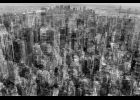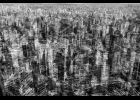Flusser Studies 01 - November 2005
Rhapsody in Blue. Vilém Flusser und der Vampyroteuthis Infernalis
The depths of the sea, their obscure inhabitants and their mysteries have always been a rich source of myths and metaphors for authors and philosophers. Fables about giant squ ids and monstrous octopuses run through the history of literature and culture. The vampire squid is only a small phylogenetic relic, but it provides a useful model for Flusser's hybrid philosophical fiction Vampyroteuthis Infernalis. Flusser slips metaphor ically into the creature’s gelatinous skin in order to speculate on the paradigms of postmodern life, measuring the abyss from the inside and producing a very peculiar, experimental form of thinking and writing. In the present era of virtual reality and co mputer simulations, we experience fiction as the only reality. According to Vaihinger's definition, fiction is a useful construct that is precisely not real, but enables human beings to create and manipulate their environments. His philosophy of “ as if ” is perhaps the fullest expression of fictionalism and shows its ambivalent potential.
Masks and Dances: Cybernetics and Systems Theory in Relation to Flusser's Concepts of the Subject and Society
This paper undertakes a close reading of Flusser’s tropes of “the mask” and “dances” to compare similarities between Fluss er’s formulation of the self and society and corresponding concepts in contemporary systems theory. Major concepts from cybernetics and systems theory such as feedback mechanisms, system and environment, and reciprocal development are illustrated through p assages from Laszlo, Maturana and Varela, and Luhmann and compared with Flusser, with the aim of demonstrating what is “cybernetic” in Flusser’s thought. Consideration is also given to the relationship between Flusser’s work and that of other contemporary social theorists who adopt systems theoretical approaches, such as Foucault , Deleuze, and Guattari.
Cartas Flusserianas: diagnóstico sobre correspondência com Sérgio Paulo Rouanet
The purpose of this essay is to comment on the reading of a set of letters exchanged by Vilém Flusser (1920 - 1991) and Sérgio Paulo Rouanet (1934). The exchang e comprising 56 letters altogether – 30 by Flusser himself – took place between 1980 and 1991. It focuse d on some of Flusser’s most important concepts: the relationship of discourse and dialogue, the idea of ‘Apparat’, the existential dimension of writing, as well as the meaning of death and entropy for a theory of communication. Rouanet’s pertinent criticism reveals also some unexpected sides of Flusser’s theoretical assumptions.
1. Flusser und der Dialog. Negentropische Klimmzüge über der Bodenlosigkeit
Flusser‘s concept of dialog cannot be comprehended from a media theoretical point of view only. A more fruitful approach emerges from within the context of Flusser’s own model of culture that forms an epicycle intended to lend meaning to human life by creating information. This approach also encompasses a consideration of the influence of Judaeo-Christian traditions. We need to understand the changes the concept of dialog has undergone on its way from Martin Buber, for example, to Vilém Flusser.
Life is absurd in the face of its bottomlessness. Therefore, strategies are developed to make it more livable. In celebration and play we tend to forget death as a menace. Most of all, however, human beings try to overcome the futility and loneliness of a life toward death by means of dialog with other human beings. Recognition of the other as a „Thou“ is both the condition of a dialog and its result. Flusser revives and secularizes the concept of relationships of mutual recognition, a motif at the core of Jewish-Christian thought. Buber allows two ways for the „I“ to realize itself, in experiencing the world or, alternatively, in relation to a „Thou“. Flusser, however, insists on the exclusivity of the creation of the „I“ in dialog. Another significant shift of the concept of dialog from Buber to Flusser is that Buber interprets dialogs among humans as merely metaphorical. To him, true meaning is only possible through a dialog with god. Flusser, however, rejects the necessity of a final transcendental rationale. Thus, he secularizes Jewish- Christian tradition: it becomes an immanent task to take over responsibility for other human beings by means of dialog.
Dialogs realize free relationships of recognition and appreciation. Today, we are threatened by discursive massification. Therefore, dialogs need to be technically and socially implemented. Discursive structures and their technical materialization ought to be changed into dialogical channels. Again, Flusser’s utopia proves to be profane: The only chance for survival and viability lies in the collective memory of culture set up by dialogical networks.
Netropolis
The pictures have been produced digitally by an algorithm that mixed, on four different levels, four photos taken on top of the tallest building overlooking the city, facing North, South, East and West. The algorithm was programmed according to a statistical rule – for instance 56% North, 34% South, 69% East and 20% West. The final image is therefore at the same time an optical condensation of the city’s appearance as well as a concentration of different information units. Najjar finds, thus, an elegant and technically creative implementation of Flusser’s concept of techno-image.

